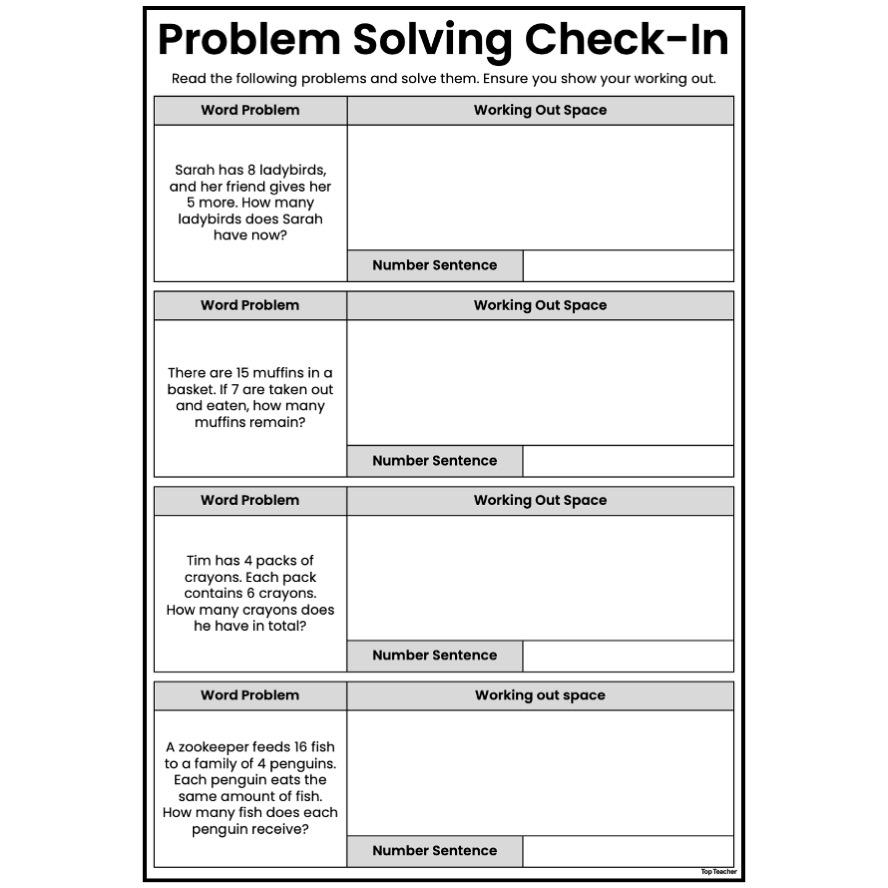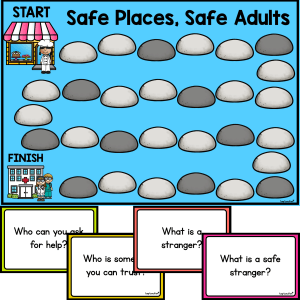Problem Solving Check-In Assessment

Description
Support your students in developing strong maths thinking and strategy use with our Problem Solving Check-In Assessment. These assessments are designed to help you gauge student understanding across all four operations while giving them space to show their working using a structured, visual approach. Ideal for use before, during, or after a unit of work, this resource gives you valuable insights into how your students tackle word problems.
Each check-in includes a variety of word problems that require students to apply their skills in addition, subtraction, multiplication, and division. Students are encouraged to use the CUBES strategy - Circle the numbers, Underline the question, Box the keywords, Eliminate unnecessary information, and Solve - to break down each problem logically. Dedicated space is provided for students to model their thinking and write a matching number sentence for each question.
Three differentiated versions are included, allowing you to easily target your assessment to different levels of ability in your classroom. Each version comes with an answer key, making it easy to mark or use as a whole-class discussion tool. Whether you're using it as a pre-assessment, a check-in during the term, or an end-of-unit review, this resource offers structure, clarity, and flexibility for monitoring growth in problem-solving.
Key Learning Outcomes:
- ✅ Apply problem-solving strategies to real-world word problems
- ✅ Use the CUBES method to identify important information
- ✅ Solve addition, subtraction, multiplication, and division problems
- ✅ Model mathematical thinking with written working out
- ✅ Match number sentences to word problems accurately
What’s Included:
- 3 differentiated check-in assessments with varying levels of difficulty
- Each assessment includes questions covering the four operations
- Space provided for CUBES strategy modelling and number sentence writing
- Answer key included for each version
Materials Needed:
- Printed check-in sheets (one per student)
- Pencils or pens
- Optional: CUBES anchor chart for classroom reference
How to Use:
- Select the appropriate assessment version based on student ability or current focus.
- Distribute to students individually or use during small group work.
- Encourage students to apply the CUBES strategy and show their working clearly.
- Have students complete the number sentence that matches their problem-solving process.
- Use the answer key for quick marking or peer review, and identify areas for follow-up support.
Ideas for Classroom Use:
- 💡 Use as a beginning-of-term pre-assessment to identify focus areas
- 💡 Assign mid-term as a check-in during a word problems unit
- 💡 Include as part of an assessment folder or portfolio
- 💡 Use as a discussion tool during small group or guided maths sessions
- 💡 Pair students to compare working strategies and discuss their processes
Top Teacher Tips:
- 💛 Print on coloured paper to easily differentiate levels or group assessments
- 💛 Use a CUBES anchor chart or prompt card to support students new to the strategy
- 💛 Allow students to use manipulatives or visual aids if needed
- 💛 Encourage students to explain their number sentence aloud before writing it
Problem Solving Check-In Assessment is a flexible, easy-to-implement tool for checking student progress with mathematical thinking. With structure for strategy modelling and support for all four operations, it’s the perfect resource for confident, evidence-based teaching.
Additional information
| Number of Pages | 6 |
|---|---|
| File Format | pptx |
| Australian Curriculum Code | AC9M3N06, AC9M4N08 |
Australian Curriculum V9
F - 6
Lorem ipsum dolor sit amet, consectetur adipiscing elit.
Lorem ipsum dolor sit amet, consectetur adipiscing elit.
Lorem ipsum/ Lorem ipsum/ Lorem ipsum
Lorem ipsum dolor sit amet, consectetur adipiscing elit.
Lorem ipsum dolor sit amet, consectetur adipiscing elit.
Lorem ipsum/ Lorem ipsum/ Lorem ipsum
Lorem ipsum dolor sit amet, consectetur adipiscing elit.
Lorem ipsum dolor sit amet, consectetur adipiscing elit.
Lorem ipsum/ Lorem ipsum/ Lorem ipsum
Lorem ipsum dolor sit amet, consectetur adipiscing elit.
Lorem ipsum dolor sit amet, consectetur adipiscing elit.
Lorem ipsum/ Lorem ipsum/ Lorem ipsum
Lorem ipsum dolor sit amet, consectetur adipiscing elit.
Lorem ipsum dolor sit amet, consectetur adipiscing elit.
Lorem ipsum/ Lorem ipsum/ Lorem ipsum





